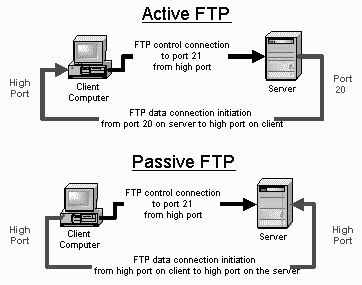Active FTP
The sequence of events for active FTP is:
1. Your client connects to the FTP server by establishing an FTP control connection to port 21 of the server. Your commands such as 'ls' and 'get' are sent over this connection.
2. Whenever the client requests data over the control connection, the server initiates data transfer connections back to the client. The source port of these data transfer connections is always port 20 on the server, and the destination port is a high port (greater than 1024) on the client.
3. Thus the ls listing that you asked for comes back over the port 20 to high port connection, not the port 21 control connection.
FTP active mode therefore transfers data in a counter intuitive way to the TCP standard, as it selects port 20 as it's source port (not a random high port that's greater than 1024) and connects back to the client on a random high port that has been pre-negotiated on the port 21 control connection.
Active FTP may fail in cases where the client is protected from the Internet via many to one NAT (masquerading). This is because the firewall will not know which of the many servers behind it should receive the return connection.
Passive FTP
Passive FTP works differently:
1. Your client connects to the FTP server by establishing an FTP control connection to port 21 of the server. Your commands such as ls and get are sent over that connection.
2. Whenever the client requests data over the control connection, the client initiates the data transfer connections to the server. The source port of these data transfer connections is always a high port on the client with a destination port of a high port on the server.
Passive FTP should be viewed as the server never making an active attempt to connect to the client for FTP data transfers. Because client always initiates the required connections, passive FTP works better for clients protected by a firewall.
As Windows defaults to active FTP, and Linux defaults to passive, you'll probably have to accommodate both forms when deciding upon a security policy for your FTP server.
Read more: A&P FTP

0 မွတ္ခ်က္:
Post a Comment